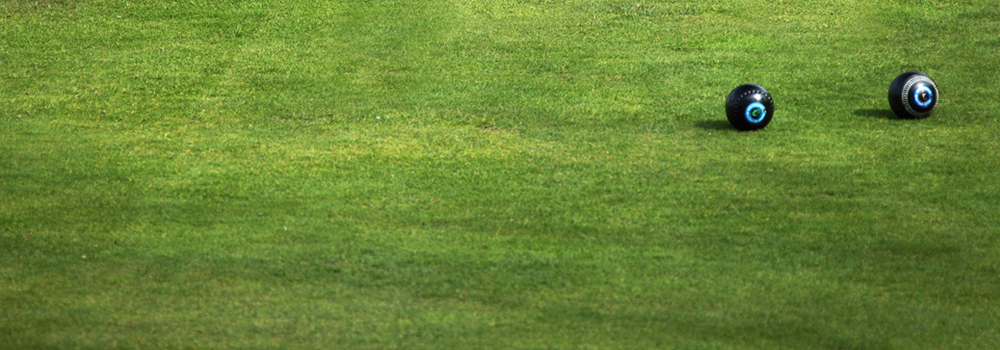
The unsettled conditions experienced in the latter part of June look likely to continue well into July. Northern regions of the UK will experience below average temperatures, blustery conditions and a good deal of rain in the form of showers. Some of these will be heavy with potential risk of flooding. Further south, whilst remaining blustery, temperatures will be more like the seasonal average, with the south and south east expected to be above average towards the end of the month.
July will be a very busy month for bowling clubs; there is usually a high demand for play, with many clubs involved in domestic competitions.
Key Tasks for July
Maintenance Regimes

The recent unpredictable weather, seen in many parts of the country will have no doubt affected your maintenance regimes or prevented matches. However, we would hope that, in between the predicted heavy rainfall, there are dry and warm spells to help promote some consistent grass growth.
- Continue to carry out routine maintenance tasks, mowing, verticutting, fertilising, watering to keep the green in a playable condition.
- Grass growth will dictate mowing frequencies, in most cases clubs are cutting daily or on a three- four times a week regime.
- Only apply fertilisers if you have significant moisture in the green; clubs that are struggling to water should refrain from applying feeds whilst the greens are dry.
- Try and keep a diary of what work you have undertaken on your green, and keep records of how it has performed; take some pictures of the green and make note of any issues/problems you have.
- Get into the habit of taking a number of soil core samples to monitor what's happening underground; a visual look at a soil profile will enable you to monitor thatch content, moisture levels and root depth.
Mowing. With regard to mowing, ensure your mower is kept sharp and set at the correct height. No two greens are the same; Height of cut (HOC) will vary from green to green, with HOC influenced by several factors, type of mower used, condition of the green, sward composition and surface levels. In general, HOC will range between 3mm-8mm during the growing season, with most clubs cutting at around 5mm.
Some clubs will reduce their mowing heights, perhaps down to 3mm, to help speed up the greens for club competitions. Prolonged mowing at these heights will lead to plant stress. As an alternative, instead of reducing the height, do a double cut (in different directions), this will speed up the greens without reducing the grass height. The speed of greens can be affected by other factors - too much thatch is the main cause of slow greens, or the fact that the greens have not had enough topdressings to maintain levels.
Irrigation. Nowadays, irrigation is an important and integral part of the turf grass management industry, especially as the demand for better quality playing surfaces has increased.
Therefore, careful consideration and investment in a decent watering system is a key requirement to managing fine turf surfaces. Most, if not all, professional sporting facilities have irrigation systems of one sort or another. Without them they would not be able to prepare and maintain their playing surfaces.
Irrigation is essential for a number of reasons:
- for plant survival and growth.
- for soil formation
- for soil strength
- for chemical transport
- for managing playability
- for presentation
Water is influential in all chemical, physiological and biological processes of plant growth. The soil/plant water relationships is critical to the sustainability of any grass plant. Having an understanding of these relationships is critical.
All grass plants are a continuum of water movement. Over 90% of the plant's water requirements are transported through the plant from the soil profile, via the roots and stem tissues into the leaves and out into the atmosphere. Knowledge of these relationships is important when designing and operating irrigation systems. The main aim is to achieve a water balance within the soil profile ensuring that the grass plant is able to access available water from the soil.
Irrigation scheduling by the water balance approach is based on estimating the soil water content. In the field, daily evapotranspiration (ET) amounts are withdrawn from storage in the soil profile. Any rainfall or irrigation are added to storage. Should the water balance calculations project soil water to drop below some minimum level, irrigation is indicated. Weather forecasts enable prediction of ET rates and projection of soil water balance to indicate whether irrigation is needed in the near future.
It is also important to state that overwatering can equally be damaging to your surface. Keeping the surface waterlogged will reduce air porosity and decline plant growth; constant shallow watering will also increase Poa annua populations. Ideally, you should apply a sufficient amount of water to flood up the green and then allow to drain for two - three days. This allows the water to get deeper into the soil profile.
Fertilising. Most groundstaff will be applying a summer N P K fertiliser, perhaps something like a 8:0:6 reducing the N and P inputs, and trying to maintain a stable balanced growth during July. The choice of material and how well it works will be dependent on factors such as soil type and weather, with moisture and air temperature being the catalyst for growth.
If you have access to water for the greens, fertiliser treatment and turf tonics can be continued in accordance with your annual programme. If you haven't got a fertiliser programme, have your soil tested; try an independent soil analysis company for an impartial set of results.
Aeration is a key activity to ensure that there is a good air/gas exchange going on in the soil profile. Providing the green is adequately irrigated, the use of a sarrel roller (depth 5mm) helps keep the surface open without disturbing the playing surface. Deeper aeration should only be done with micro tines when conditions allow, as we do not want to risk disturbing the surface, especially during the playing season.
Topdressing is usually carried out in spring and autumn in conjunction with the renovation programmes. However, some bowling clubs have a policy of applying topdressing materials during the season. It is important that an appropriate material is sourced to ensure compatibility with the existing rootzone materials of your green. The last thing you want to encourage are rootbreaks in the green.
Rink Ends

Many players and committees insist on keeping the ends in the same position and direction, usually for obscure reasons such as "it's my lucky rink".
Playing in the same direction with the rink ends in the same position will cause uneven wear on what should be a flat, level green. Ruts and depressions will occur, causing the bowl not to roll true.
The rink settings should be moved laterally and directionally every 3 days or so, playing across and up and down the green.
On the same basis, all rinks should be used in rotation so that wear is evenly spread across the green. Just using the centre links will quickly affect the level of the green.




Monitoring the performance of your playing surfaces is a key skill that should be adopted by all Groundsman/Greenkeepers. With the aid of modern technologies, tools and a camera you can now monitor the performance and the condition of your sward in many ways.
For many years the turf industry has promoted the use of Performance Quality Standards (PQS) to ascertain the standard of sport pitch maintenance.
It is important to survey and measure the performance of your facilities, with modern technologies we can now measure all manner of aspects of the pitch/golf green or artificial pitch to ensure it meets any stated guidelines by the sports governing bodies.
These can include measuring sward height, composition of grass species, soil temperature, weed content, levels over a 3m level, hardness and infiltration rates (porosity) of the soil rootzone.
In recent years, we have seen the development of GPS mapping devices that can measure chlorophyll, moisture content and deviation in levels. Soil tests will also help determine soil type, nutrient status of the soil, organic matter content, CEC capacity and soil pH.
Keeping a record of these parameters will help you have a better understanding of what is going on within your playing surface and enable you to make better decisions on what maintenance inputs you will need to undertake to maintain surface playability.

A selective weedkiller will help control any broadleaf weeds; the timing of application is key, apply when weed growth is vigorous.
Recently, we have seen incidences of turf diseases such as Microdochium nivale (fusarium) on greens. Fairy Rings are in evidence and Red Thread has swept spectacularly through a lot of outfield turf. With such a peak in disease activity in mid-summer we are expecting continued problems over the next few months; therefore acting preventatively by applying a systemic fungicide such as Heritage Maxx will be the most effective form of control. Application before symptoms are visible but the threat is imminent is the key to success when adopting a preventative approach.
Fairy rings are today one of the most common diseases encountered by groundsmen and greenkeepers alike, and most will have experienced them under their supervision.
It is an unsightly and annoying blight on any sports turf playing surface, but the damage that these rings can cause depends on their type, location, biological environment and abundance.
Fairy rings are generally caused by fungi that are a part of the basidiomycetes genus. There are more than 50 fungi known to cause similar reactions though. When the disease first appears, it is important to correctly identify the symptoms, as there are three types of fairy rings to be found in amenity sports turf in this country:
- TYPE I Marasmius oreades
- TYPE II Scleroderma & Lycoperdon spp
- TYPE III Hygrophorus & Psilocybe spp
If the fairy rings have already taken hold, there are still control methods available. The most important factor at this point is to identify what type of fairy ring your course/pitch is afflicted with. As type 3 fairy rings are mainly aesthetic, their ability to reduce the aesthetic quality of turf can be decreased by physical removal of mushrooms/toadstools. However, for type 1 and 2 fairy rings, there are many options available for effective control.
Please note: More information on these and many others can be found here: www.pitchcare.com/useful/diseases.php
Ensure you look after your equipment and store safe and secure, it is a good idea to get into a habit of washing down and and cleaning after use.
Keep your mower clean and well serviced, check bottom blades and cylinders for sharpness.

Our next course:
SEAFORD, East Sussex - Tuesday 23 August
Further details of the course can be found on the Grounds Training website.
Delegates attending the Bowling Green course and using the accompanying manual will be able to develop their own skills, working knowledge and expertise, by understanding the method of instruction and the maintenance principle it sets out.
Included in the Course Manual, there are working diaries showing the range of tasks needed to be accomplished each month. The Course Manual is available for purchase separately.
In addition, we are able to arrange courses to be delivered on site to groups of 6 – 10 people. Email Chris Johnson for information.
Many bowling clubs have hedges surrounding their greens. July is a good time to trim and reshape these, thus reducing any potential shading or access problems.
Check and inspect ditches, floodlights, structures and any site furniture for damage; keep the site clean and maintain a tidy appearance throughout the facility.


